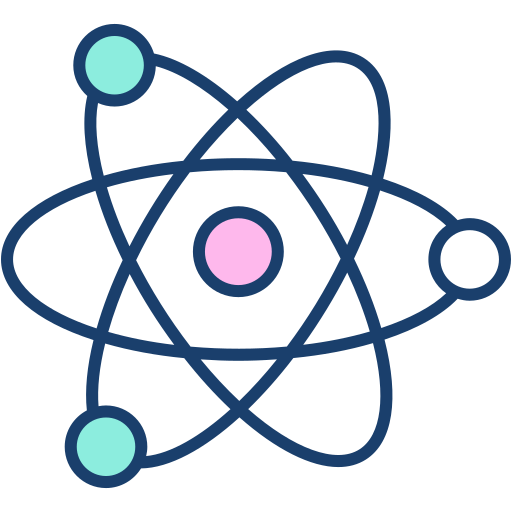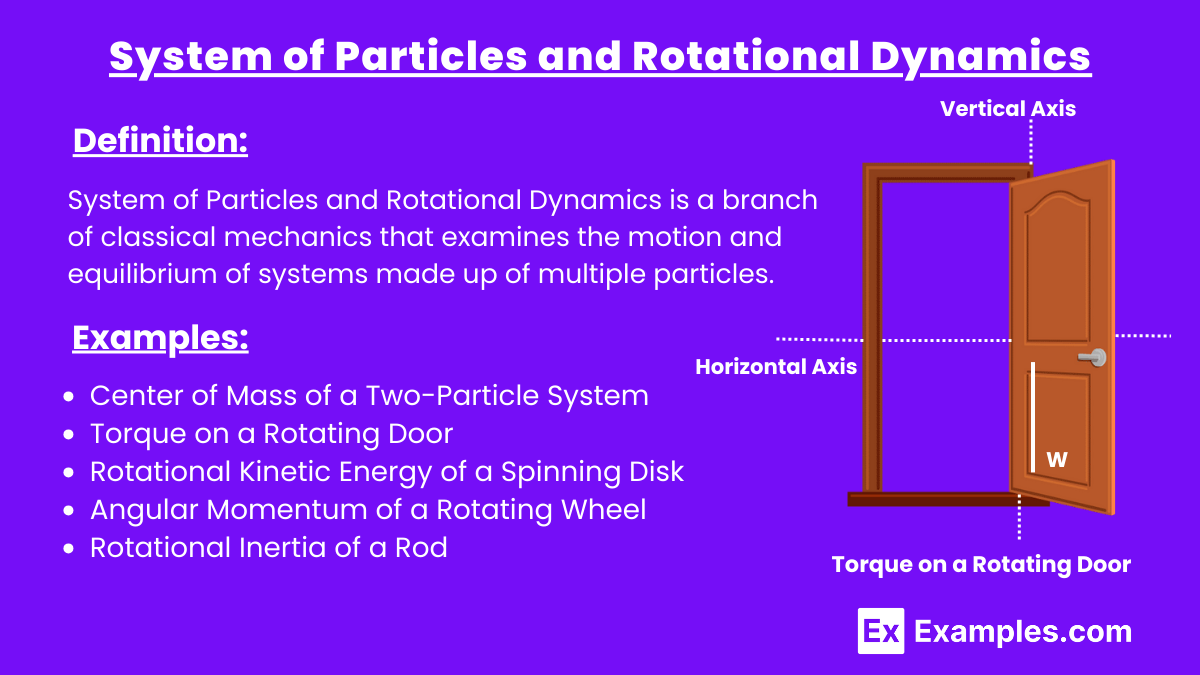What is the center of mass of a system of particles?
The point where the total mass of the system is concentrated
The point where gravitational force acts
The point where external forces are zero
The geometric center of the system


System of Particles and Rotational Dynamics involves the study of the motion of systems consisting of multiple particles and the rotation of rigid bodies. In this domain, we analyze the center of mass, which represents the average position of all the mass in a system, and examine how forces and torques affect the motion of the entire system. Understanding rotational dynamics requires comprehending angular displacement, velocity, and acceleration, as well as the moment of inertia, which quantifies the distribution of mass around an axis of rotation. Key principles such as the law of conservation of angular momentum and Newton’s laws for rotation play a crucial role in predicting and explaining rotational motion in physical systems.
System of Particles and Rotational Dynamics is a branch of classical mechanics that examines the motion and equilibrium of systems made up of multiple particles. It focuses on how forces affect the collective motion, considering individual masses and positions, and explores rotational motion around a common axis. Key concepts include torque, angular momentum, and rotational kinematics, essential for understanding the behavior of complex systems.
Two particles with masses 3 kg and 5 kg are positioned at (2, 4) m and (6, 8) m, respectively. The center of mass is calculated as:
R= (3×2+5×6)/3+5, (3×4+5×8)/3+5= (4.5,6.5)m
A 15 N force is applied perpendicular to a door at a distance of 1.2 meters from the hinge. The torque is:
τ=1.2m×15N=18Nm
A disk with mass 4 kg and radius 0.3 m spins at 20 rad/s. Its rotational kinetic energy is:
Krot=1/2 × 0.5 × 4 × (0.3)2 × 202=36J
A wheel with a moment of inertia of 0.8 kg·m² rotates at 10 rad/s. Its angular momentum is:
L = 0.8kg⋅m2 ×10rad/s = 8kg⋅m2/s
A diver tucks into a ball, reducing her moment of inertia from 2 kg·m² to 1 kg·m², doubling her angular velocity from 2 rad/s to:
ω = 2×2/1 = 4rad/s
A rod with mass 3 kg and length 2 m rotates about its end. The moment of inertia is:
I =1/3 × 3 × 22= 4kg⋅m2
A bicycle wheel spinning at high speed remains stable due to its angular momentum, resisting changes in orientation.
A solid sphere with mass 5 kg and radius 0.4 m has a moment of inertia of:
I = 2/5 × 5 × (0.4)2 = 0.32kg⋅m2
A merry-go-round with a moment of inertia of 300 kg·m² accelerates from rest to 2 rad/s under a torque of 100 Nm. The angular acceleration is:
α =100/300 =1/3 rad/s2
A top with a moment of inertia of 0.02 kg·m² experiences a torque of 0.1 Nm. Its angular acceleration is:
α = 0.1/0.02 =5rad/s2
A gyroscope precesses around the vertical axis due to the torque caused by gravity acting on its center of mass, demonstrating the conservation of angular momentum.
A hollow cylinder with mass 6 kg, radius 0.5 m, and angular velocity 15 rad/s has a rotational kinetic energy of:
Krot = 21 × 6 × (0.5)2×152=168.75J
The center of mass is the point in a system of particles or a body where the total mass can be considered to be concentrated. It is the weighted average location of all the mass in the object. This concept is crucial in understanding the motion of objects and systems in physics. Understanding the center of mass helps in analyzing the motion of objects, determining balance and stability, and understanding rotational dynamics. For a system of particles, the center of mass (COM) is calculated using the formula:
Linear momentum is a fundamental concept in physics, particularly in the study of mechanics. Understanding the linear momentum of a system is crucial for analyzing the motion and interactions of objects. Linear momentum (p) of an object is defined as the product of its mass (m) and its velocity (v):
Torque (τ) is a measure of the rotational force acting on an object. It is defined as the cross product of the position vector (r) and the force vector (F):
Angular momentum (L) is a measure of the rotational momentum of an object. For a particle, it is defined as the cross product of the position vector (r) and the linear momentum vector (p):
System of Particles and Rotational Dynamics are crucial concepts in physics with numerous applications in both everyday life and advanced technology. Here are some key applications:
Rotational motion occurs when an object spins around an internal axis, like a wheel turning around its axle.
Torque is the measure of the force that causes an object to rotate about an axis. It is the rotational equivalent of force.
The moment of inertia quantifies the resistance of an object to changes in its rotational motion about an axis.
Torque causes angular acceleration in an object, changing its rotational motion based on the object’s moment of inertia.
Angular momentum is the rotational equivalent of linear momentum, describing the quantity of rotation of an object.
The principle states that if no external torque acts on a system, its total angular momentum remains constant.
A rigid body is an object with a fixed shape and size that doesn’t deform under the action of forces.
The parallel axis theorem states that the moment of inertia about any axis parallel to an axis through the center of mass is I+Md2.
The perpendicular axis theorem applies to planar objects, stating that the moment of inertia about an axis perpendicular to the plane is the sum of moments of inertia about two perpendicular axes in the plane.
Angular acceleration is the rate of change of angular velocity over time, usually measured in radians per second squared.
Text prompt
Add Tone
10 Examples of Public speaking
20 Examples of Gas lighting
What is the center of mass of a system of particles?
The point where the total mass of the system is concentrated
The point where gravitational force acts
The point where external forces are zero
The geometric center of the system
What does the moment of inertia depend on?
Mass only
Distribution of mass and axis of rotation
Shape only
Velocity of rotation
What is the relationship between torque and angular acceleration in rotational dynamics?
Torque is inversely proportional to angular acceleration
Torque is directly proportional to angular acceleration
Torque is equal to the moment of inertia
Torque does not affect angular acceleration
Which of the following quantities is conserved in the absence of external torques?
Linear momentum
Angular momentum
Force
Kinetic energy
What is the effect of increasing the distance of mass from the axis of rotation on the moment of inertia?
It decreases the moment of inertia
It increases the moment of inertia
It has no effect on the moment of inertia
It makes the moment of inertia zero
Which law explains the rotational analog of Newton's first law?
Law of Conservation of Mass
Law of Inertia
Law of Conservation of Momentum
Law of Universal Gravitation
How is the angular velocity defined in rotational motion?
The rate of change of angular displacement
The rate of change of linear displacement
The total angle covered
The rate of change of mass
If a disk and a ring have the same mass and radius, which has a larger moment of inertia about the central axis?
Disk
Ring
Both have the same moment of inertia
It depends on the material
What does the angular momentum of a system depend on?
Force and time
Mass and velocity
Moment of inertia and angular velocity
Displacement and acceleration
What happens to the angular velocity if the moment of inertia of a rotating body is halved while keeping the angular momentum constant?
Angular velocity doubles
Angular velocity halves
Angular velocity remains constant
Angular velocity becomes zero
Before you leave, take our quick quiz to enhance your learning!

